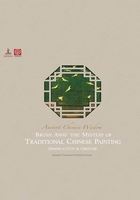
八十七神仙卷 (bā shí qī shén xiān juàn)
Eighty-Seven Celestials
The ancient artwork entitled Bashiqi Shenxian Juan — or “Eighty-Seven Celestials” — depicts 87 godly figures descending from the heavens in a grand procession. Painted in the typical Chinese baimiao or “plain drawing” style, the brushwork has long been deemed as the very best of its genre in the traditional Chinese painting.
A 30 × 292 cm handscroll, ink on silk, the painting is also believed to be the only extant baimiao silk painting by Wu Daozi (680-759 AD), who is regarded not only as the greatest painter of the Tang Dynasty (618-907 AD), but also “one of the masters in the seventh century,” according to Michael Sullivan (1916-2013), a British expert on Chinese art history.
“Eighty-Seven Celestials” is attributed to artist Wu Daozi, the celebrated painter from the Tang Dynasty (618-907 AD). The artist employed a special line painting technique to depict the pleats of the dresses and floating ribbons, which became known as the “Wu Breeze” by his successors.

Artist: Wu Daozi (680-759 AD)
Year: Tang Dynasty (618-907 AD)
Type: Ink on silk
Dimensions: 30 × 292 cm
Location: Xu Beihong Memorial Hall, Beijing
Born in central China’s Henan Province, Wu lost his parents when he was young and spent his childhood in abject poverty. To survive, Wu studied painting under some local artisans.
The young Wu worked hard and studied assiduously. When he was 20, Wu had already earned a reputation as a painter with peerless talent. Soon afterwards, he was summoned by the emperor to become an official painter in the imperial court.
The new role restricted Wu’s freedom in creating new paintings, but it
also provided him with the opportunity to mix with other top artists, calligraphers and men of letters. In addition, he was invited to travel to many places with the emperor.
Wu was known for his consummate brush techniques in painting not only spectacular landscapes, but also vivid figures, particularly in Buddhist or Taoist murals.
It is said that Wu painted a total of more than 300 murals and about 100 scrolls in his lifetime. He also pioneered several painting techniques, such as the shubi (or “sketchy”) style of landscape painting and the “Wu Breeze,” which refers to the fluid line drawing technique employed by the artist to depict pleats, the folds of dresses and robes and floating ribbons.
Some art critics say that the ribbons painted by Wu were so light and flowing that one could almost feel the breeze fluttering them.
The highly-detailed “Eighty-Seven Celestials” was commissioned by a general during the Kaiyuan Reign (713-742 AD) of Tang Emperor Xuanzong. The general asked Wu to create this spiritual painting as a consecration to his mother who passed away recently.
Before he began to paint, Wu asked the general to put on his armor and demonstrate his finest swordsmanship on horseback. After watching the general’s powerful and breathtaking performance, Wu began to draw the first line on the silk.
According to legend, Wu finished this masterpiece in a single session. In the painting, he lavished great care on such features as exquisite hairdos and bristling whiskers, graceful dresses and robes, beautiful musical instruments and delicate handicrafts, elegant flowers and plants. The plump faces of the celestial figures not only typify a trend in Tang painting, but also reflect the dynasty’s prosperity.

➊
Wu Daozi lavished great care on the details of hairdos, whiskers, dresses, instruments and flowers in “Eighty-Seven Celestials.”
There were no records on the transmission of this masterpiece until 1937, when Xu Beihong (1895-1953), a prominent Chinese painter, discovered it in Hong Kong and bought it from a German collector.
In the following tumultuous years of war in China and Asia, Xu tried to protect the “Eighty-Seven Celestials.” But the painting was stolen during an air raid launched by the Japanese in Kunming, a provincial capital in southwest China in May 1942.

➋
“Eighty-Seven Celestials” features the fluid line drawing technique created by Wu Daozi.
Fortunately, two years later, one of Xu’s students found this painting in a neighboring province. Xu immediately raised a large sum of money by borrowing from friends and selling his own paintings to buy back the precious ancient artwork.
Now the masterpiece is in the collection of the Xu Beihong Memorial Hall in Beijing.